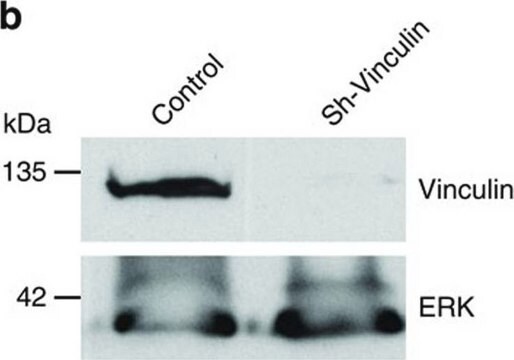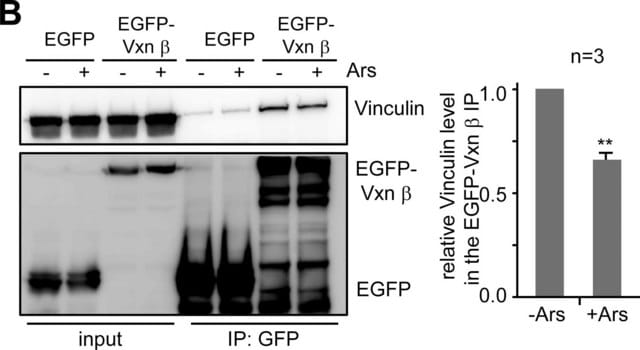General description
Anti-Vinculin antibody, Mouse monoclonal (mouse IgG1 isotype) is derived from the VIN-11-5 hybridoma produced by the fusion of mouse myeloma cells and splenocytes from a mouse immunized with smooth muscle vinculin from chicken gizzard. Vinculin, also known as metavinculin is highly conserved scaffolding protein localized to focal adhesions and adherens junctions. Vinculin is a 116 kDa protein with 1066 aminoacids. Vinculin comprises eight anti-parallel α-helical bundles organized into five distinct domains. Domains 1-3 are arranged into a tri-lobar head with a molecular mass of 95 kDa and diameter of 80Å . The vinculin head binds many proteins including talin, IpaA, β-catenin, α-catenin and α-actinin. A 61 amino acid, proline-rich linker region (residues 837-878) connects the head and tail. The linker binds vasodilator-stimulated phosphoprotein (VASP), vinexin, ponsin and Arp2/3. The vinculin tail (amino acids 879-1066) is a 30 kDa helical bundle containing five helices connected by short loops (3-8 residues). The tail contains binding sites for vinculin head domain, paxillin, acidic phospholipids and actin. Within the cell vinculin exists either as open, active form or as a closed, auto-inhibited state. The vinculin gene is mapped to human chromosome 10q22.2. Metavinculin (150 kDa), a splice variant of vinculin, is co-expressed with vinculin in muscle tissues. These proteins are localized to the cell membrane, the I-band in the sarcomere and to the intercalated discs.
Immunogen
smooth muscle vinculin from chicken gizzard
Application
Monoclonal Anti-Vinculin is recommended to use in various immunochemical assays, including immunoblot (~120kDa), immunofluorescence, immunohistochemistry and immunoprecipitation.
Biochem/physiol Actions
Vinculin is a cytoplasmic actin binding protein. It plays a key role in cell to cell and cell to matrix adhesion. It mediates adhesion by directly binding to F-actin and subsequently causing actin polymerization and binding of actin remodelling proteins. At high concentrations, Vinculin can undergo oligomerization and may be involved in the transmembrane assembly of adhesion plaques. Vinculin has been implicated in the control of adhesion, cell morphology and motility and muscle functions. Mutations in vinculin, affects the binding of vinculin to F-actin and impairs cell migration. It is a susceptible gene for dilated and hypertrophic cardiomyopathy. Mutations in vinculin may lead to sudden unexplained nocturnal death syndrome (SUNDS). In relation to cell adhesion and motility function, Vinculin is considered to have a crucial effect on tumor cells ability to invade tissues and hence to metastasize. Thus, it is suggested to be implicated in diagnosis of cancer progression and metastasis prognosis.
Physical form
Solution in 0.01 M phosphate buffered saline, pH 7.4, containing 15 mM sodium azide.
Disclaimer
Unless otherwise stated in our catalog or other company documentation accompanying the product(s), our products are intended for research use only and are not to be used for any other purpose, which includes but is not limited to, unauthorized commercial uses, in vitro diagnostic uses, ex vivo or in vivo therapeutic uses or any type of consumption or application to humans or animals.





